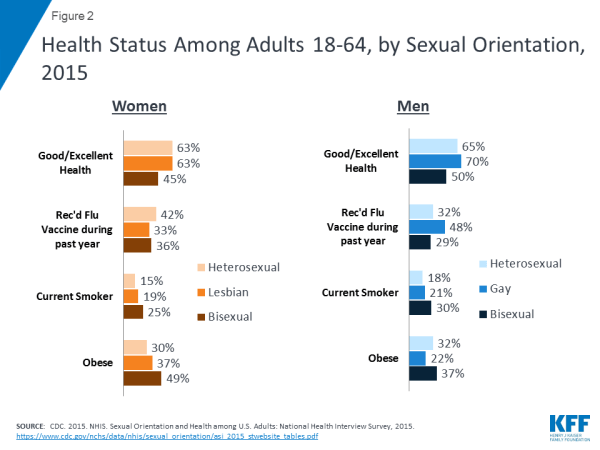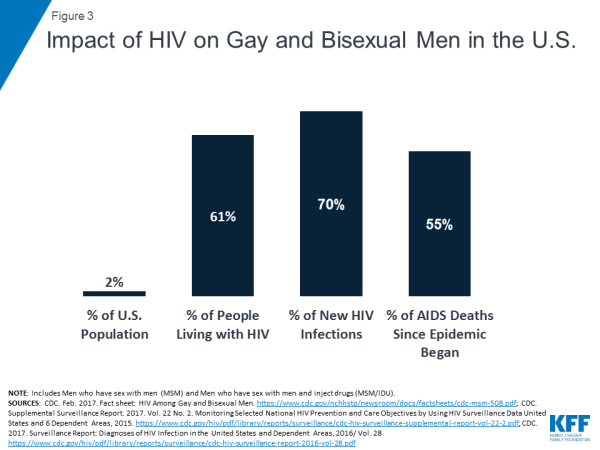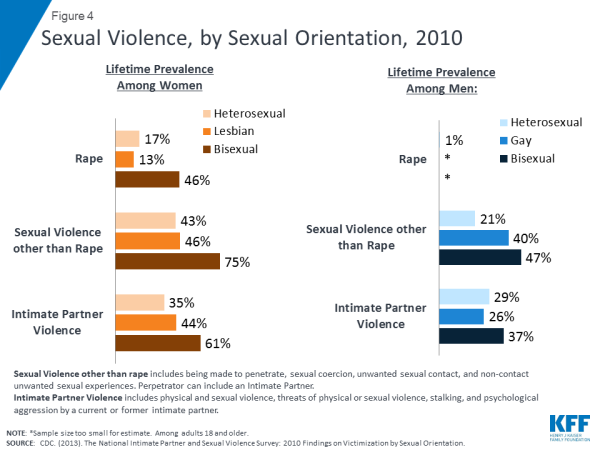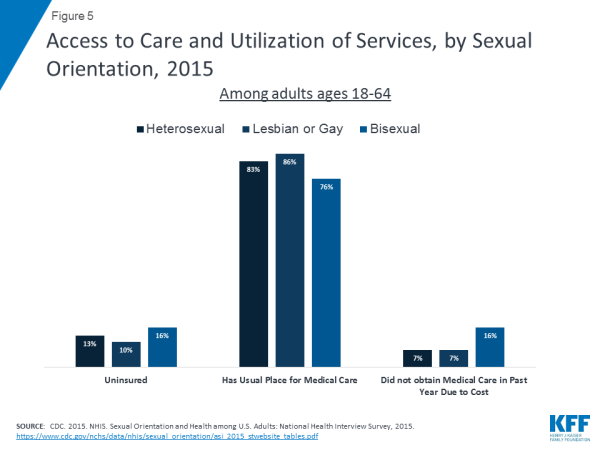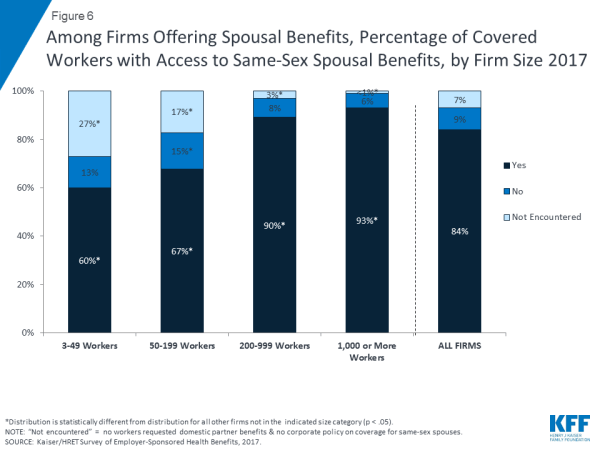Health and Access to Care and Coverage for Lesbian, Gay, Bisexual, and Transgender (LGBT) Individuals in the U.S.
Health Challenges
Health is shaped by a host of social, economic, and structural factors.1 For LGBT individuals, these factors include the experience and impact of discrimination, stigma, and ostracism which affect health outcomes, access, and interaction with the health system care.2,3, 4 Research available to date finds that while LGBT people have many of the same health concerns as the general population, they experience some health challenges at higher rates, and face several unique health challenges.
Chronic Conditions
Studies have found that LGBT people experience worse physical health compared to their heterosexual and non-transgender counterparts.5, 6
- A recent literature review found that self-identified LGB individuals are more likely than heterosexuals to rate their health as poor, have more chronic conditions, and have higher prevalence and earlier onset of disabilities. Overall, LGB people report more asthma diagnoses, headaches, allergies, osteoarthritis, and gastro-intestinal problems than heterosexual individuals.7
- Additionally, there are differences between subgroups within the LGBT community. Lesbian and bisexual women report poorer overall physical health and higher rates of asthma, urinary tract infections, and Hepatitis B and C than heterosexual women. Lesbian and bisexual women also report heightened risk for and diagnosis of some cancers and higher rates of cardiovascular disease diagnosis. Similarly, gay and bisexual men report more cancer diagnoses and lower survival rates, higher rates of cardiovascular disease and risk factors, as well as higher total numbers of acute and chronic health conditions such as headaches and urinary incontinence than heterosexual men.8
- According to data from the NHIS, fewer bisexual women reported excellent or very good health compared to heterosexual women and lesbians. Similarly, fewer bisexual men reported good/excellent health compared to gay or heterosexual men. (Figure 2)9 In a separate survey, fewer transgender individuals report very good or excellent health than the rates found in NHIS for LGB people.10 Similarly, a study of Massachusetts residents, transgender persons are the least likely among LGBT individuals to self-report their health as Excellent or Very Good (67% vs. 79%) and are twice as likely to report limitations in daily activities due to impairment of health problems (33% vs. 16%).11
- LGB individuals on average have higher rates of some risk factors for chronic illnesses. Obesity rates are higher among lesbian and bisexual women compared to heterosexual women, but are lowest among gay men. However, there were no significant differences by sexual orientation for women or men in rates of meeting physical activity guidelines.
HIV/AIDS and Sexually Transmitted Infections (STIs)
One of the most significant health challenges facing the LGBT community has been the HIV/AIDS epidemic’s impact on gay and bisexual men, and transgender women. After experiencing a dramatic rise in new infections in the 1980s, efforts by the gay community and public health officials helped to bring HIV incidence down; however, in recent years, new infections among gay and bisexual men in the U.S. have been on the rise, the only group for which infections are increasing (Figure 3).
- In 2014, gay and bisexual men and other men who have sex with men (MSM), while representing an estimated 2% of the U.S. population, accounted for six in ten (61%) people living with HIV in the United States, and 70% of new HIV infections.12,13
- Between 2008 and 2014, annual HIV infections stabilized among all MSM but this trend was not observed among all racial/ethinic groups. HIV infections declined 18% among white MSM (from 9,000 to 7,400 infections), stabilized among black MSM (about 10,000 infections per year) but increased by 20% among Latino MSM (from 6,100 to 7,300 infections).14
- Despite a stabilizing in rates, young, black MSM accounted for more new diagnoses in 2015 than any other subgroup by race/ethnicity, age and sex.15
- Transgender women, particularly transgender women of color, are also at high risk of HIV. A 2013 study estimated HIV prevalence among transgender women to be 22%.16
- The CDC recommends routine HIV screening in health-care settings for all adults, aged 13-64, and repeat screening, at least annually, for those at high risk (e.g., that sexually active gay and bisexual men may benefit from more frequent testing, such as every 3 to 6 months).17 However, according to a nationally representative survey conducted by the Kaiser Family Foundation, many do not meet this level. While seven in ten gay and bisexual men say they have gotten an HIV test at some point in their lives, just 30 percent say they were tested within the past Three in ten (30%) say they have never been tested for HIV, rising to 44% of those under age 35. The leading reason that men give for not having had a recent test is that they do not consider themselves at risk for HIV.18
- Access to medical care is critical for the health of people with HIV. Among MSM diagnosed with HIV in 2014, 61% received care and 51% achieved viral suppression.19 In addition, according to the Kaiser survey, three in ten (31%) gay and bisexual men either say they don’t have a regular place to go for medical care or they don’t have a regular physician. These men (who tend to be younger, lower-income, and more racially diverse) are also less likely to report discussing HIV with doctors or getting tested for HIV.
- To date, there has only been one likely case of female-to-female sexual transmission of HIV in the United States.20 However, HIV is an issue that affects lesbians as well as bisexual women, since individuals who identify as lesbian may still have sexual relationships with men, and lesbians and bisexual women are also at risk of HIV via transmission modes that do not involve sexual contact (such as injection drug use).
- STI rates are higher among some LGB groups than heterosexuals, and rates have been increasing for some infections. For example, MSM account for more than eight in ten (82%) new gonorrhea and primary and secondary syphilis cases when the gender of sex partner is known. In addition, antibiotic-resistant gonorrhea
- may be higher among MSM.21 MSM also account for 10% of all new hepatitis A infections and 20% of new hepatitis B infections.22 Given the strong interaction between HIV and other STIs, this is a particular concern for MSM.
- Human Papillomavirus (HPV) is the most common STI and is a major cause of cervical, anal, and mouth cancers.23 MSM are 17 times more likely to develop anal cancer than men who only have sex with women.24 The HPV vaccine, which protects against certain strains of the virus that are associated with anal cancer, could reduce anal cancer rates among future generations of MSM
Behavioral and Mental Health
Research has found that LGBT individuals are at elevated risk for some mental health and behavioral health conditions, with studies finding that they are two and a half times more likely to experience depression, anxiety, and substance misuse.25,26 The history of discrimination and stigma, including lack of acceptance from family members, contributes to higher rates of mental illness.27,28 In fact, until the 1970s, homosexuality was considered a mental illness in the Diagnostic and Statistical Manual (DSM) of Mental Disorders and by various professional organizations. The diagnosis “gender dysphoria,” which has replaced the transgender diagnosis in the DSM, is intended to communicate the emotional distress that transgender people may experience as well as promote insurance coverage of services related to gender transition, such as counseling or hormone therapy, that typically have not been covered by insurance plans29 Further, stigma and prejudice against sexual and gender minorities remain pervasive and continue to have negative consequences for the mental health of the LGBT population.30
- The recent NHIS provides the first national comparisons of gay, lesbian and bisexual adults to heterosexual adults on alcohol consumption, smoking status, and one measure of mental health status (Table 1).
- Heavy consummation of alcoholic beverages during at least one day in the past year was reported by more bisexual (47%) and gay or lesbian (36%) adults than heterosexual adults (28%). Rates among men of all sexual orientations were substantially higher than for women.
- Smoking rates were higher among LGB adults compared to heterosexuals. A separate meta-analysis of several studies found that overall, LGBT people smoke cigarettes at 1.5 to 2.5 times the rate of heterosexual and non-transgender people.31
- Nearly one in six bisexual women experienced serious psychological distress in the past 30 days, more than three times the rate of heterosexual women. Approximately 3% of heterosexual men reported experiencing serious psychological distress.
- Other studies have used state-level data or sample populations to identify mental health trends among LGBT individuals. Nearly one fifth (19%) of bisexual adults in Massachusetts report they had recently seriously considered suicide, compared to 4% of lesbian and gay adults and 3% of heterosexuals.32 There are notable differences between subgroups, with the rate highest among bisexual women (26%), followed by bisexual men (11%), gay men (6%), and approximately 3% among all other subgroups. Another nationwide study found a reported 41% prevalence of suicide attempts among the transgender population.33
- Research suggests that MSM have higher use of certain substances. One study has estimated that MSM are more than 12 times as likely to use amphetamines and almost 10 times as likely to use heroin as heterosexual men. However, it’s important to note that research in this field is older and data are not necessarily comparable to the heterosexual population.34
Sexual Assault and Physical Violence
Sexual assault and physical violence can have lasting consequences for victims, families, and communities.35 LGBT individuals experience higher rates of sexual and physical violence compared to heterosexual and non-transgender individuals. Violence toward LGBT people has led to public policy responses. For example, federal legislation as well as some state laws allow for the classification of violence based on gender identity or sexual orientation bias as a “hate crime,” which has implications for penalties as well as funding to states and locales for deterrence and surveillance of these crimes.36 Key statistics include the following:
- A recent poll of LGBT adults found that two thirds had experienced some form of discrimination because of their sexual orientation or gender identity, including subjection to slurs, rejection by a friend or family member, being physically threatened or attacked, receiving poor service at a place of business or treated unfairly by an employer, or made to feel unwelcome at a place of worship; a full 30% said they had been physically threatened or attacked.37
- Many women and men have experienced some form of sexual violence, but the rates are significantly higher among some LGBT groups. It is estimated that almost half (46%) of bisexual women have been raped, as have 17% of heterosexual and 13% of lesbian women. More than four in ten heterosexual and lesbian women and the majority (75%) of bisexual women have experienced other forms of sexual violence, such as coercion or harassment. Six in ten (61%) bisexual women have encountered intimate partner violence (IPV), as have 44% of lesbian and 35% of heterosexual women (Figure 4).38
- While sexual violence rates are higher among women overall, bisexual and gay men experience significantly higher rates than heterosexual men. Four in ten gay men and nearly half of bisexual men have encountered sexual violence other than rape. More than one-third (37%) of bisexual men have faced partner violence. For both men and women, the perpetrators were predominantly male.
- Anti-LGBT bias also puts LGBT people at risk for physical violence. According to the FBI’s crime reporting surveillance, one in five single-bias incident hate crimes was due to sexual orientation bias.39 Studies using convenience samples have shown a significant number of LGBT individuals have been victims of physical and verbal assaults, as well as personal property damage, due to their sexual orientation or gender identity.40 One recent nationally representative study examined self-reported experiences with physical violence due to sexual orientation among gay men, lesbian women, and bisexual individuals, and found almost 8% of individuals have experienced physical violence once and 5.5% have experience physical violence at least twice. Gay men were the most likely to experience physical violence due to their sexual orientation.41 Transgender people, particularly transgender women and transgender people of color, are also at particular risk of physical violence.42 Statistics from the National Coalition of Anti-Violence Programs indicate that half of the victims of anti-LGBT bias-motivated murders in 2012 were transgender women and the majority were also people of color.43
Adolescent and Young Adult Health
Adolescence and young adulthood are often times when individuals begin to identify as LGBT and in fact high school students identify as LGB at higher rates than do adults in any age group.44,45 As mentioned above, the YRBS recently found that 89% of high school students identify as heterosexual, 2% as gay or lesbian, 6.0% bisexual, and 3% reported that they were unsure of their sexual identity.46 While these times can be challenging for many individuals, they are often especially so for LGBT youth. Despite growing societal acceptance and understanding, some young people still suffer discrimination at the hands of their family and friends and in their schools and communities, experiences which can lead to serious challenges, such as housing problems, that affect health. There is growing awareness about bullying and violence affecting LGBT youth, including dating and sexual violence. These include efforts to promote greater attention to fostering inclusive school climates, teaching youth about online safety, establishment of reporting processes in schools and communities when violence or bullying occur, and referring young people for professional mental and behavioral health services when needed. In addition, LGB high school students report engaging in some higher risk taking activities than do their heterosexual peers including with respect to actives such as drug, alcohol use and sexual behavior.47 Key statistics include the following:
- Like their adult counterparts, students who identify as lesbian, gay, or bisexual, experience higher rates of mental illness and suicidality. LGB students more likely to have felt sad or hopeless compared to their heterosexual peers (60% v. 26%), seriously considered suicide (43% v. 15%), or attempted suicide (29% v. 6%).48
- LGB students are also more likely to engage in certain risk taking activities, including having ever tried alcohol (75% v. 63%), marijuana (53% v. 38%), or cocaine (11% v. 4%). LGB students were also less likely to report condom use during last sexual intercourse than heterosexual students (48% v. 58%).49
- Like their adult counterparts, youth who identify as a sexual or gender minority experience higher rates of discrimination compared to the general population. Additionally, LGBT youth are more likely to be homeless and live in poverty than non-LGBT youth. Research has found that parental rejection can increase the likelihood that an LGBT youth will suffer from depression, attempt suicide, use illegal drugs, and/or engage in risky sexual behaviors.50
- Approximately 40% of homeless youth are LGBT, and the leading reasons for homelessness among this group are due to family rejection.51
- Almost two thirds (64%) of LGB students and 4 out of 10 (44%) transgender students report feeling unsafe at school because of their sexual orientation or gender identity.52
- LGB students experience higher rates of violence than do heterosexual students including having been threatened or injured with a weapon, been in a physical fight, or injured in a fight. The share of students who have experienced dating violence is two times higher among LGB students than heterosexual students (18% v 8%) and more than three times as many LGB youth report ever physically forced to have sexual intercourse against their will, compared to their heterosexual peers (18% vs. 5%).53
- Recent research estimates that 20,000 LGBT youth will receive conversion therapy from a licensed health care provider before the age of 18 and an additional 57,000 youth will receive “treatment” from a religious or spiritual advisor.54 This is contrary to the recommendation from professional medical organizations, including the American Psychological Association, American Medical Association, and America Association of Pediatrics, which oppose the practice citing its impact as harmful and ineffective.55
Insurance Coverage and Access to Care
Research has shown that LGBT populations have different patterns of health coverage and utilization of services and has begun to document gaps within the delivery system in meeting the needs of the LGBT population.
- While LGB individuals have similar rates of insurance coverage and uninsurance, and saw similar gains in coverage under the ACA (see below), in some cases access to care differs for this population. In particular, research finds that on some measures, bisexual individuals have more limited access to care while lesbian and gay individuals have rates comparable to heterosexual adults (Figure 5). In particular, bisexual adults fared poorer than other groups in terms of having a usual place to go for medical care and going without medical care due to cost.
- A separate 2013 survey found that among LGBT individuals estimated to have incomes under 400% of the federal poverty level (FPL), almost 4 in 10 had medical debt and more than 4 in 10 reported postponing medical care due to costs.56
- Research studies on same-sex couples find that LGB individuals have higher rates of unmet medical need because of cost and are less likely to have a regular provider. Research has also found that women in same-sex couples are less likely than heterosexual married women to have received timely medical care for both primary and specialty services. Among men in couples, gay men are three times as likely as their heterosexual counterparts to report delays in obtaining needed prescription medicines.57
- Marriage is tied to access to health insurance. Prior to the Supreme Court’s Windsor ruling, however, same sex married couples were only able to obtain coverage for their spouse as a domestic partner, if their employer provided such coverage, and these benefits were considered taxable income. Under the Windsor and Obergefell rulings, federal and state employees with same-sex married spouses are guaranteed the benefits afforded to opposite-sex married spouses but other employers may continue to elect to cover only opposite-sex married spouses (in states or localities without additional protections).
- Indeed, recent nationally representative research shows that in 2017 nearly six in ten (57%) firms that offer health benefits to opposite-sex spouses, offer coverage to same-sex spouses58, that share is much higher (88%) among large employers (those with 200 or more workers) which is significant as most covered U.S. workers (71%) are employed by these firms.59 Because most covered workers are employed by large firms, which are more likely to offer the benefit overall, 84% of covered workers with access to opposite-sex spousal coverage also have access to same-sex spousal coverage. Almost all workers (93%) at firms with 1,000 or more employees have access to this benefit whereas fewer than two-thirds (64%) of workers at the smallest firms (between 3 and 49 employees) have access (see figure 6). 60 In addition, states have the option of enacting their own equal employment legislation protecting on the basis of sexual orientation. Beyond the requirements for state and federal employers, these Supreme Court rulings are through to have influenced the expansion of employment benefits, including health benefits, to same-sex spouses more broadly. Indeed, one study found that the legalization of same-sex marriage in New York was associated with an increase in employer-sponsored insurance among same-sex couples.61
- Some studies have found that lesbian women in couples have lower rates of breast and cervical cancer screenings than married heterosexual women.62 In addition to lower mammography rates, lesbian women on average have higher rates of some risk factors for breast cancer, including greater alcohol use and lower likelihood of childbearing. 63,64
- The transgender population is much more likely to live in poverty and less likely to have health insurance than the general population. Research reflects the impact of these barriers. In one survey of transgender individuals, nearly half (48%) of respondents postponed or went without care when they were sick because they could not afford it.65 In addition, many health plans include transgender-specific exclusions that deny transgender individuals coverage of services provided to non-transgender individuals, such as surgical treatment related to gender transition, mental health services, and hormone therapy.66
- An individual’s relationship with providers is another important component of access to care. Significant shares of LGBT individuals report negative experiences when seeking care, ranging from disrespectful treatment from providers and staff, to providers’ lack of awareness of specific health needs. In a survey of LGB people, more than half of all respondents reported that they have faced cases of providers denying care, using harsh language, or blaming the patient’s sexual orientation or gender identity as the cause for an illness.67 Fear of discrimination may lead some people to conceal their sexual orientation or gender identity from providers or avoid seeking care altogether.
- For transgender persons, discrimination may be as personal as refusing to use the patient’s chosen name or as structural as providers’ lack of knowledge about how to provide appropriate care to transgender people. For example, most transgender men still have a cervix and should be screened for cervical cancer, which requires a sensitive approach.68 Studies of the transgender community show that up to 39% of transgender people have faced some type of harassment or discrimination when seeking routine health care, and many report being denied care outright or encountering violence in health care settings.69,70
- Medical education does not routinely encompass LGBT health issues. More than half of medical schools and public health school curricula lack instruction about the health concerns of LGBT people beyond work related to HIV/AIDS.71,72 However, the medical community’s awareness of LGBT health needs has grown. Several professional medical societies have formed policies and guidance that advocate on behalf of fair treatment and access for LGBT patients and health providers.73 For example, the American Medical Association (AMA) has issued an explicit nondiscrimination policy as well as numerous other statements that recognize prior discriminatory practices in the medical setting, the importance of better understanding and addressing LGBT health needs, the impact of discrimination on health and well-being, and the need to include sexual orientation in research.
- The World Professional Association for Transgender Health also maintains a set of standards and principles to guide health care professionals in providing health care to transgender people.74 Additionally, in 2011, the Joint Commission, an independent non-profit national organization that accredits and certifies more than 20,000 health care organizations and programs in the U.S., began to require that hospitals prohibit discrimination based on sexual orientation, gender identity and gender

